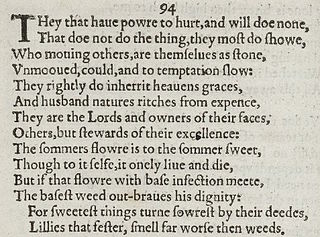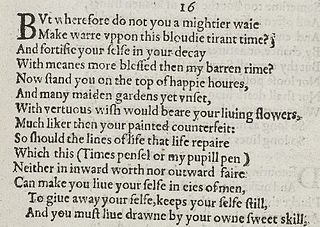
Sonnet 3 is one of 154 sonnets written by the English playwright and poet William Shakespeare. It is often referred to as a procreation sonnet that falls within the Fair Youth sequence.

Sonnet 18 is one of the best-known of the 154 sonnets written by English poet and playwright William Shakespeare.

Sonnet 94 is one of 154 sonnets written by the English playwright and poet William Shakespeare. It is a member of the Fair Youth sequence, in which the poet expresses his love towards a young man.

Sonnet 6 is one of 154 sonnets written by the English playwright and poet William Shakespeare. It is a procreation sonnet within the Fair Youth sequence. The sonnet continues Sonnet 5, thus forming a diptych. It also contains the same distillatory trope featured in Sonnet 54, Sonnet 74 and Sonnet 119.

Sonnet 10 is one of 154 sonnets written by the English playwright and poet William Shakespeare. It is a procreation sonnet within the Fair Youth sequence.

Sonnet 11 is one of 154 sonnets written by the English playwright and poet William Shakespeare. It is a procreation sonnet within the 126 sonnets of the Fair Youth sequence, a grouping of Shakespeare's sonnets addressed to an unknown young man. While the order in which the sonnets were composed is undetermined, Sonnet 11 was first published in a collection, the Quarto, alongside Shakespeare's other sonnets in 1609.

Sonnet 13 is one of 154 sonnets written by the English playwright and poet William Shakespeare. It is a procreation sonnet within the Fair Youth sequence.

Sonnet 15 is one of 154 sonnets written by the English playwright and poet William Shakespeare. It forms a diptych with Sonnet 16, as Sonnet 16 starts with "But...", and is thus fully part of the procreation sonnets, even though it does not contain an encouragement to procreate. The sonnet is within the Fair Youth sequence.

Sonnet 16 is one of 154 sonnets written by the English playwright and poet William Shakespeare. It is among those sonnets referred to as the procreation sonnets, within the Fair Youth sequence.
Sonnet 17 is one of 154 sonnets written by the English playwright and poet William Shakespeare. It is the final poem of what are referred to by scholars as the procreation sonnets with which the Fair Youth sequence opens.

Sonnet 20 is one of the best-known of 154 sonnets written by the English playwright and poet William Shakespeare. Part of the Fair Youth sequence, the subject of the sonnet is widely interpreted as being male, thereby raising questions about the sexuality of its author. In this sonnet the beloved's beauty is compared to both a man's and a woman's.

Sonnet 22 is one of 154 sonnets written by the English playwright and poet William Shakespeare, and is a part of the Fair Youth sequence.

Sonnet 42 is one of 154 sonnets written by the English playwright and poet William Shakespeare. It is a part of the Fair Youth section of the sonnets addressed to an unnamed young man.

Sonnet 56 is one of 154 sonnets written by the English playwright and poet William Shakespeare. It is a member of the Fair Youth sequence, in which the poet expresses his love towards a young man. The exact date of its composition is unknown, it is thought that the Fair Youth sequence was written in the first half of the 1590s and was published with the rest of the sonnets in the 1609 Quarto.

Sonnet 61 is one of 154 sonnets written by the English playwright and poet William Shakespeare. It is a member of the Fair Youth sequence, in which the poet expresses his love towards a young man.

Sonnet 63 is one of 154 sonnets published in 1609 by the English playwright and poet William Shakespeare. It is one of the Fair Youth sequence. Contrary to most of the other poems in the Fair Youth sequence, in Sonnets 63 to 68 there is no explicit addressee, and the second person pronoun is not used anywhere in sonnets 63 to 68.

Sonnet 90 is one of 154 sonnets written by the English playwright and poet William Shakespeare. It is a member of the Fair Youth sequence, in which the poet expresses his love towards a young man.

Sonnet 111 is one of 154 sonnets written by the English playwright and poet William Shakespeare. It is a member of the Fair Youth sequence, in which the poet expresses his love towards a young man.

Sonnet 114 is one of 154 sonnets written by the English playwright and poet William Shakespeare. It is a member of the Fair Youth sequence, in which the poet expresses his love towards a young man.

Sonnet 115 is one of 154 sonnets written by the English playwright and poet William Shakespeare. It is a member of the Fair Youth sequence, in which the poet expresses his love towards a young man.





















